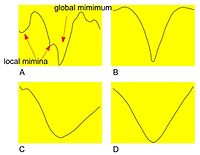Cost functions used in MIPAV algorithms
A similarity or cost function measures the similarity between two images. During the registration the adjusted image V is transformed using the various transformation functions. And the similarity S(U;Vt) between the reference image U and transformed image Vt is then calculated.
Note: in MIPAV, we use the term cost function to refer to the negative cost function. That means that we assume that the transformation that gives the smallest value of the chosen inverse cost function is the transformation that also gives the best alignment.
Contents
Background
For the registration algorithms, such as OAR, the main approach for determining an optimal transformation is to
- Calculate a cost function,
- Determine how it changes as individual transformation parameters are varied,
- And find the parameters that minimize the value of the cost function.
The figure shows a plot of a sample cost function for a selection of transformation parameters.
The cost functions implemented in MIPAV:
Powell algorithm
In MIPAV, most of the methods and algorithms use the Powell algorithm to find the global minimum of the chosen cost function. For more information about the Powell algorithm, refer to [1].
Correlation Ratio
Given two images I and R, the basic principle of the Correlation Ratio method is to search for a spatial transformation T and an intensity mapping f such that, by displacing R and remapping its intensities, the resulting image f(R* T) be as similar as possible to I. This could be achieved by minimizing the following correlation ratio function:
<math> min(T,f) of \displaystyle\sum\limits_{k} {I (x_k)-f(R(T(x_k)))} </math>
which integrates over the voxel positions <math>x_k</math> in the image I.
Image types
Correlation Ratio can be used in multimodal image registration, e.g. that involves Magnetic Resonance (MR), Computed Tomography (CT), and Positron Emission Tomography (PET) images.
Laplacian Zero-Crossing
The laplacian zero-crossing is a binary edge feature used for edge detection, see also Edge Detection: Zero X Laplacian algorithm. Convolution of an image with a laplacian kernel approximates the 2-nd partial derivative of the image. The laplacian image zero-crossing corresponds to points of maximal (or minimal) gradient magnitude. Thus, laplacian zero-crossings represent "good" edge properties and should, therefore, have a low local cost meaning edge detection. If IL(q) is the laplacian of an image I at pixel q, then
<math> \displaystyle\left\{0; if I_L (q) =0 </math>
